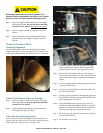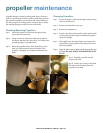
Lubricate the Shift and Throttle System
Because this process should be completed while all movable com-
ponents of the drive train are NOT in motion, MasterCra recom-
mends this be done while the boat is out of the water.
Step 1: Ensure the engine is OFF and disconnect the engine
safety starting switch. Be sure that the throttle/shi
control lever is in neutral. e engine must be cool.
Step 2: Open the engine box and locate the shi and throttle
cable ends.
Step 3: Shi to full-throttle-forward.
Step 4: Lubricate the cable ends and connections with a coat-
ing of waterproof marine multi-purpose grease.
Step 5: Lubricate the pivots and linkages with a light grease.
Step 6: Shi the control lever from full-throttle-forward to full-
throttle-reverse several times to work the lubricant in.
Check the Ballast Pump Impeller
is applies only to boats equipped with some type of ballast
system. e number of ballast pumps varies from system to system.
Authorized MasterCra dealers can provide guidance to locate
any and all pumps.
Step 1: Remove two (2) of the cover screws and retain the
screws for the reinstallation process. Swing the cover
out of the way to allow access to the impeller location.
Step 2: Using needle-nose pliers, pull the old impeller out of
the casing.
Step 3: Install a new impeller. (It is intentionally larger than
the case. While gently squeezing it in, ensure that the
paddle wheels angle in the same direction—counter-
clockwise—all the way around.)
Step 4: Slide the plate back into place. No silicone is necessary.
Due to the built-in gasket, tightening the screws should
prevent leakage.
Inspect the Complete Fuel System
for Leakage
Although the boat engine is similar to an automobile engine, the
engine compartment diers substantially. e underside of an
automobile engine compartment is totally open to the atmo-
sphere. is allows complete air circulation and ventilation. A
boat engine is housed in a closed compartment, the underside of
which is the bottom (hull) of the boat.
e enclosed engine compartment limits the ventilation of
gasoline and oil fumes. Because conned gasoline vapors mixed
with a little air can form an explosive atmosphere, it is important
to be especially vigilant in performing the following two (2)
operations:
MasterCraft 2009 Owner’s Manual - Page 16-7


















